Most mornings I wake up when my cabin drops to 36 degrees F (2 C) but this morning I slept in till it was 26 F (-3 C). To start my fire I crumble up some newspaper, throw some wood and bark on it, give it a squirt of lamp oil and light it. This morning the lamp oil was frozen but the fire started just fine without it. The basin of water I use to wash my hands was even iced over.
Category: Cabin and Car living
How to poo in the woods
 Go a fair distance from the trail, a campsite, or a water source. Dig a hole. I have found the little plastic orange shovel is useless for digging a hole. When the digging is good, my foot, a stick, or a rock will work just as well and when the digging is hard, the shovel is worthless. When the digging is hard, I look for natural holes like uprooted trees, or turn over rocks that have sunk into the earth.
Go a fair distance from the trail, a campsite, or a water source. Dig a hole. I have found the little plastic orange shovel is useless for digging a hole. When the digging is good, my foot, a stick, or a rock will work just as well and when the digging is hard, the shovel is worthless. When the digging is hard, I look for natural holes like uprooted trees, or turn over rocks that have sunk into the earth.
 For toilet paper, I use a stick or rock big enough to keep my hands away from any chance of fecal contamination. There is speculation that it isn’t the water that makes hikers sick but there own feces.
For toilet paper, I use a stick or rock big enough to keep my hands away from any chance of fecal contamination. There is speculation that it isn’t the water that makes hikers sick but there own feces.
For when I feel a need for toilet paper, I carry a few paper towels in a ziplock sandwich bag. When I’m in a situation were a stick won’t do, paper towels work much better than toilet paper, travel better, and can be wetted for a more thorough cleaning.
It is thought of as a good practice to pack out any paper that you use. Some people have burnt it and caused huge forest fires. (there is a sign on the PCT that says, “this forest fire started by a PCT thru-hiker burning his toilet paper�? )
If there is any chance of fecal contamination to my hands, I bring out my wash kit and wash them.
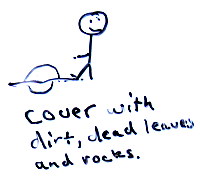 If I have used the hole from an uprooted tree, there is lots of loose soil to bury my poo in. If I have used the hole from a rock, I rake what surface duff and dead leaves I can find over the poo and put the rock back on top of all of it. From reading the The Humanure Handbook: A Guide to Composting Human Manure, I know that this is not the way that poo composts best. It needs to be kept moist and covered loosely with plant material so that it can get very hot and kill the bad stuff. It is, however, the way things are done on the trail because we don’t want to encounter other peoples poo.
If I have used the hole from an uprooted tree, there is lots of loose soil to bury my poo in. If I have used the hole from a rock, I rake what surface duff and dead leaves I can find over the poo and put the rock back on top of all of it. From reading the The Humanure Handbook: A Guide to Composting Human Manure, I know that this is not the way that poo composts best. It needs to be kept moist and covered loosely with plant material so that it can get very hot and kill the bad stuff. It is, however, the way things are done on the trail because we don’t want to encounter other peoples poo.
Related posts: Hiker bidet, Peeing in the woods
Non-Refrigerated eggs
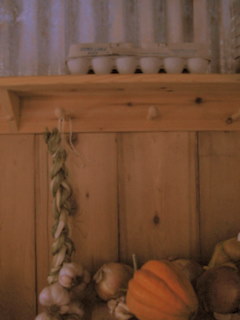
On the PCT (Pacific Crest Trail), I once used the partial fuel canisters left in the hiker box to cook up some hard-boiled eggs to bring with me on the next section. I carried a bigger pot in those day, I filled it with hard-boiled eggs and then doled them out to myself along the way.
I don’t have a refrigerator at the cabin that I’m now living at but I find that the eggs last at least a month with out refrigeration. When researching refrigerating eggs on the internet, I learned that refrigeration of eggs is a North American thing and that in other countries they are stored on the shelf.
When in Java, I lived with a family that had a little open air store; they had a bowl of eggs sitting on the counter for sale. I was concerned about this bowl of eggs, day after day just sitting there, un-refrigerated in the hot Java weather. They told me that they had soaked them in hot salt water for a while to preserve them. I ate one. It tasted like a perfect hard-boiled egg that hadn’t been cooked too long. They said that if they didn’t sell in 2 weeks that they would bury them for a while and then try to sell them again.
Laen has this to say about it:
For an explanation of why this is, read: Science of Cooking : “Is it okay to leave eggs un-refrigerated?�?.
It seems the reasoning is this:
* 1 in 20,000 eggs is infected with salmonella.
* Leaving an egg unfrigerated allows salmonella to multiply.
* Salmonella can be dangerous.
But then, you can also kill salmonella by cooking the egg enough.
So, you’re taking a teeny tiny risk by not refrigerating, but you can counter that risk by cooking the eggs enough to kill the bacteria.
Delicious monotony
Five years ago, I sold my house and all my stuff and bought a water access only cabin in coastal BC. I didn’t have a boat so I would pay a water taxi to drop me off and would tell him to come back and get me in a month or sometimes two.
It would be easy to live off the land up there as there are lots of berries, mushrooms, edible plants and seafood to eat. The cabin came with a row boat and a crab trap. I bought a cheap fishing pole and some hooks and lures. There were muscles lying on the beach in front of my cabin. A ways up the inlet there were oysters and seaweed beds. It was a veritable Garden of Eden. However, I almost always ate the food I had brought with me instead of living off the land as I had dreamed of.
I had dreamed of.
I decided to only bring up a very monotonous yet nutritional diet, thinking that I would tire of the monotony and go out and forage for food. However the two meals that I would make for myself proved to be so delicious and satisfying that I was always happy to eat them. They were:
Super oats.
Oatmeal, raisins, almonds, cinnamon, soy protein powder. (Even better with brown sugar) Cook the oatmeal and raisins with extra water so that when you add the soy protein powder it isn’t too dry.
Garlic fried rice.
Sauté a half to a whole head of garlic along with a lot of dried red peppers in oil, add cooked brown rice( let the rice sit for a bit uncovered so it dries out some) , add an egg to it all and stir it around until the egg is cooked. (Even better when sprinkled with seasoned gourmet rice vinegar.)
Simple composting toilet
 This is my composting toilet. I use it, throw the paper in it, and cover with sawdust. When it is full, I dump in under a big pine tree and rake pine needles over it. Next, I rinse out the bucket with my saved gray water and throw the water on the pile. There isn’t any smell.
This is my composting toilet. I use it, throw the paper in it, and cover with sawdust. When it is full, I dump in under a big pine tree and rake pine needles over it. Next, I rinse out the bucket with my saved gray water and throw the water on the pile. There isn’t any smell.
I’m thinking about building a small addition on to my cabin, so it could be kept in it its own room. It’s a very simple system that I learned from reading the book The Humanure Handbook: A Guide to Composting Human Manure. Now Free and downloadable at: http://www.jenkinspublishing.com/humanure.html
You don’t have to use sawdust. You can use what ever you have: bark, duff, whatever. For material to cover it outside, the idea is to have something fluffy that allows a lot of air to get to it so it can heat up, kill any bad stuff, and compost fast. In the book, he recommends straw. I use pine needles because that’s what I have, but you could use leaves, weeds, or what ever. My bucket is called a Luggable Loo. It’s a five gallon bucket with a toilet seat lid. In the book he builds a nicer looking system. You could just use a 5 gallon bucket with a regular lid.
Washing without soap
I don’t like using much soap to wash my dishes or me because without copious amounts of hot water, a soapy residue stays on, so, I have been using baking soda when I have a greasy pan to wash and sometimes I use it to wash my hair as well, as I learned to do from this Mother Earth News article. The baking soda acts as the alkali and the grease in the pan or the oil in my hair acts as the fat, put them together and you have soap. It has been working really well until I ran out of baking soda. Lye (the alkali that soap is usually made with) is made from wood ash so I tried washing a greasy pan using hot water and ashes from my wood stove, and it worked great.
Backwoods carpet cleaning
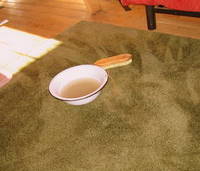 I used a pan of hot water (no soap) and a scrub brush and the rug looks a lot better. Last year I tried cleaning my rug in the snow as told to me in this Mother Earth News article but it wasn’t a complete sucess and dragging my dirty rug out into the brilliant snow and sunshine made it look that much more dingier.
I used a pan of hot water (no soap) and a scrub brush and the rug looks a lot better. Last year I tried cleaning my rug in the snow as told to me in this Mother Earth News article but it wasn’t a complete sucess and dragging my dirty rug out into the brilliant snow and sunshine made it look that much more dingier.
Light
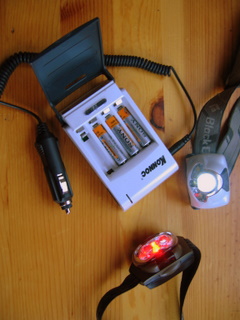 One of the joys of living with out electric lights is just laying back and enjoying the world getting darker and lighter. Lights are nice to have if I want to read a book or cook somthing but it’s not mandatory that everytime it starts to get dark I have to have light.
One of the joys of living with out electric lights is just laying back and enjoying the world getting darker and lighter. Lights are nice to have if I want to read a book or cook somthing but it’s not mandatory that everytime it starts to get dark I have to have light.
Though I have a small solar system, the only thing it runs is my laptop. For light I use a L.E.D. headlamp. With it I can read, cook, clean up, bring in wood, ect. This one has a really super bright spot light for when you need a lot of light and three not so bright L.E.D.s for other times. It takes 3 AAA batteries. I also bought this one
at Wal-mart for 13 dollars that has 2 white LED’s and one red one; you can switch between the white and red. I wanted a red one so that I could look at a star chart without losing my night vision. I’ve been happy with that headlamp as well and it’s nice to have in case of company or when I need to change my batteries in my other headlamp.
I just got this battery charger so that I don’t have to buy so many batteries. It is dual voltage for international travel and comes with an ac cord, a dc cord and a USB cord so that you can recharge your batteries through your computer. It says that it will charge 4 AAA’s
in 22 minutes.

If I have company or I just want some nice light to hang out with, I use oil lamps or tealights. I use Ultra-pure lamp oil in my lamps; anything else will stink up my cabin. It’s expensive, Wal-mart sells it for 4.49 for 64 ounces which is much cheaper than anywhere else.
Library for a nomadic wilderness dweller.
 It would be impossibly expensive and take up too much room in my cabin to buy enough books to last me through even one winter. So rather than sit with my own thoughts, last year I bought a laptop, and a solar panel to power it, and headed to my cabin to be snowed in. I didn’t have a phone then, so I couldn’t connect to the internet, but I stayed happy reading the folowing.: Project Gutenberg DVD This is a free dvd with 9600 books on it, whose copyrights have expired. Most of the books are at least 80 years old but as long as you have power for your laptop you will always have something good to read. You can download it or they will mail it to you. There is also a CD version but with only 600 books on it. Project Gutenberg has 19,000 books at their web page that you can download for free.
It would be impossibly expensive and take up too much room in my cabin to buy enough books to last me through even one winter. So rather than sit with my own thoughts, last year I bought a laptop, and a solar panel to power it, and headed to my cabin to be snowed in. I didn’t have a phone then, so I couldn’t connect to the internet, but I stayed happy reading the folowing.: Project Gutenberg DVD This is a free dvd with 9600 books on it, whose copyrights have expired. Most of the books are at least 80 years old but as long as you have power for your laptop you will always have something good to read. You can download it or they will mail it to you. There is also a CD version but with only 600 books on it. Project Gutenberg has 19,000 books at their web page that you can download for free.
I have the 2005 deluxe edition: a huge stand alone computer encyclopedia, atlas, and dictionary. Most of the authors that I would read in Project Gutenberg also had entries and often literary guides in Encarta. A search box can be docked on your task bar for handy looking up of words or subjects. I found it really nice to be reading a Project Gutenberg book and coming to a word I didn’t know, copying it and pasting it in the dictionary search bar and getting a definition with the option of also hearing it spoken. Often when I’m reading a paper book and I come to some reference, word or place that I’m not familiar with I just keep reading but with this handy encyclopedia, atlas, and dictionary it’s so easy to look things up.
This encyclopedia also has articles from magazines like, National Geographic and Scientific America. In addition to all this it has an extensive history of African Americans; the slave narratives alone will keep you in good reads for weeks.
 And for any pragmatic advice on cabin living, I would turn to:Thirty years of Mother Earth News articles on CD
And for any pragmatic advice on cabin living, I would turn to:Thirty years of Mother Earth News articles on CD
Backpacking stove
 A stove is nice to have. Life is just better when you have a hot beverage to drink. A hot meal is not necessary but psychologically a hot meal can be both soothing and uplifting. And life is all about where your mind is.
A stove is nice to have. Life is just better when you have a hot beverage to drink. A hot meal is not necessary but psychologically a hot meal can be both soothing and uplifting. And life is all about where your mind is.
The backpacking stove I now use is the Brunton CRUX Compact Foldable Canister Stove, it weighs 3.1 ounces. The reason I bought this one is it’s higher than average BTU output.
It’s a canister stove. I like canister stoves because I can use them anywhere, from on the trail to a vehicle to a hotel room and they heat water fast. They also pose less of a fire hazard than other backpacking stoves. I have found the canisters in Thailand and in most places in the US. Worldwide they probably are available but you might have to spend a day finding them once you arrive.
You can’t bring the canisters on the plane but you can mail them to yourself, domestically, by writing on the box: “Surface Mail Only, Consumer commodity, ORM-D.”
One medium 8 oz (12oz total weight) canister will usually last me 10 days for all my meals and hot beverage needs. When traveling and using it just for a cup or two of coffee in the morning and the occasionally pot of ramen, 2- 8 oz canisters lasted me more than 3 months. The small 4 ounce canisters barely last 3 days.
The canisters are recyclable, though you may have to puncture them first. The biggest draw back on the canister stove is the price of the canisters, ranging anywhere from 3.00 to 6.50 apiece; acceptable when I’m traveling but pricy for cabin use. Sometimes discount stores like Wal-Mart and Fred Meyer have an off brand of fuel for much less then the outdoor stores and works just as well.
All I ever do is boil water on it: I add food and water, heat to boiling or almost boiling, turn off the stove and let the food sit in the pot with the foil lid on it and finish cooking without the stove going.
There are lots of lightweight stove options ranging from wood to gas, some you make yourself, at http://zenstoves.net/
If you get a canister stove that comes with a peizo igniter, remove it, it weighs more than a small Bic lighter and is less useful and less dependable. Also, carry a spare Bic lighter. I also threw out the case that the stove came with. It’s just unnecessary weight. The canisters fit in my pot for storage all though with some of them I have to turn them upside down to make them fit. I store the stove, can opener and lighter in a light plastic sandwich bag before storing them in the bottom of the pot, so they don’t get wet, and then put the fuel canister in the pot and keep everything in a 8�? x 9�? nylon ditty bag.
Yoga class for recluses
 I first heard about Richard Hittleman’s Yoga: 28 Day Exercise Plan
I first heard about Richard Hittleman’s Yoga: 28 Day Exercise Plan from Ray Jardine in Beyond Backpacking
. He said that it was one of the things he did to prepare for a long hike. It’s not just a twenty eight day course, it’s a life long yoga program that will make you strong, flexable and healthy. The book is horribly dated; it’s from the seventies, but I can overlook that.
Cabin stove.
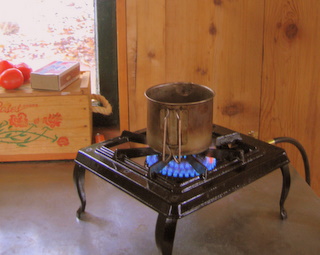
This is my stove. I bought it online at Cabellas along with a 12′ propane hose and regulator. I drilled a hole in the floor using a 1″ spade Bit and a cordless drill
; the 1″ bit was to big but it was the smallest size spade bit I had. Since there is very little clearance under that side of the cabin, barley enough to get my hand in, I tied a thin rope off inside and dropped the other end down the hole. Then I reached under and grabbed the rope and tied it to the inside end of the hose. Then I went inside and pulled it in. I stuffed foil around the gap around the hole and the hose.
I have it hooked up to a 30 lb propane tank outside. I think this will last me all winter, but I have lots of spares if it doesn’t. The stove simmers well, yet it also has a high 15,000 BTU output.
Update: It’s March 27th and the stove has worked well all winter. I’m still on the same 30 gallon propane thank that I originally hooked it up to.
Update: On October 30th, almost a year after I hooked it up, my 30lb propane tank finally ran out.
My cabin’s water system.
 I don’t have a well so I fetch my water in a bunch of one gallon bottles. There is a spring about ¼ mile away but, in the summer I worry about the cows polluting it so I pay the town 10 dollars for 500 gallons and fill up at the community spigot. In the winter, I put 4 jugs in my backpack when I head out for my walk, and fill them up at the spring. I also have a 55 gallon drum in my loft that feeds to the sink below it. I fill it up using a funnel and the one gallon jugs. Mostly, I just use the water straight out of the jugs and save the water in the barrel for when I need running water, like to rinse my dishes. This system combined with 8 gallons of hot water on my wood stove is a comfortable system.
I don’t have a well so I fetch my water in a bunch of one gallon bottles. There is a spring about ¼ mile away but, in the summer I worry about the cows polluting it so I pay the town 10 dollars for 500 gallons and fill up at the community spigot. In the winter, I put 4 jugs in my backpack when I head out for my walk, and fill them up at the spring. I also have a 55 gallon drum in my loft that feeds to the sink below it. I fill it up using a funnel and the one gallon jugs. Mostly, I just use the water straight out of the jugs and save the water in the barrel for when I need running water, like to rinse my dishes. This system combined with 8 gallons of hot water on my wood stove is a comfortable system.
I keep the empty bottles on a rope wrapped though their handles. That way I just have to grab the rope and sling all the empties into my pickup.
In the winter I leave a couple of the bottles outside to freeze then put them in my cooler to keep my fresh food cool.
Every day you should…

